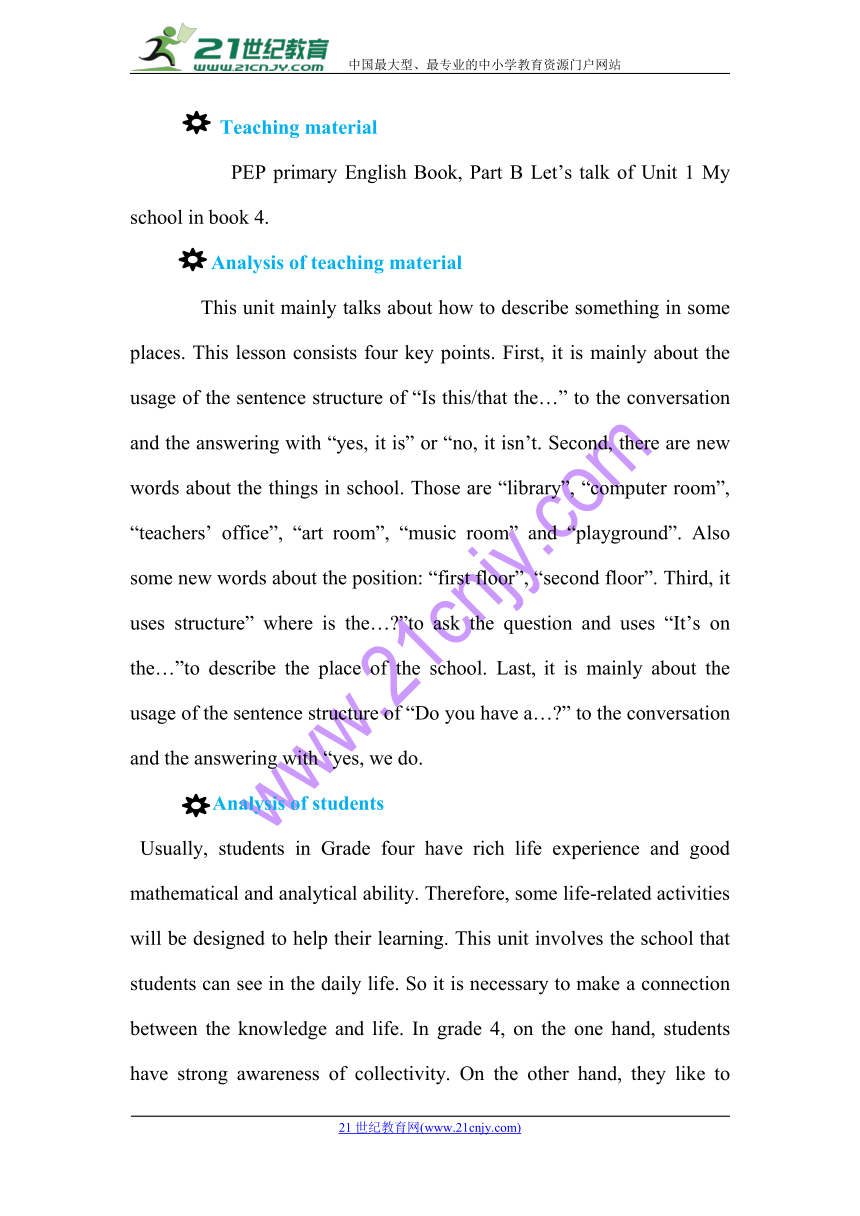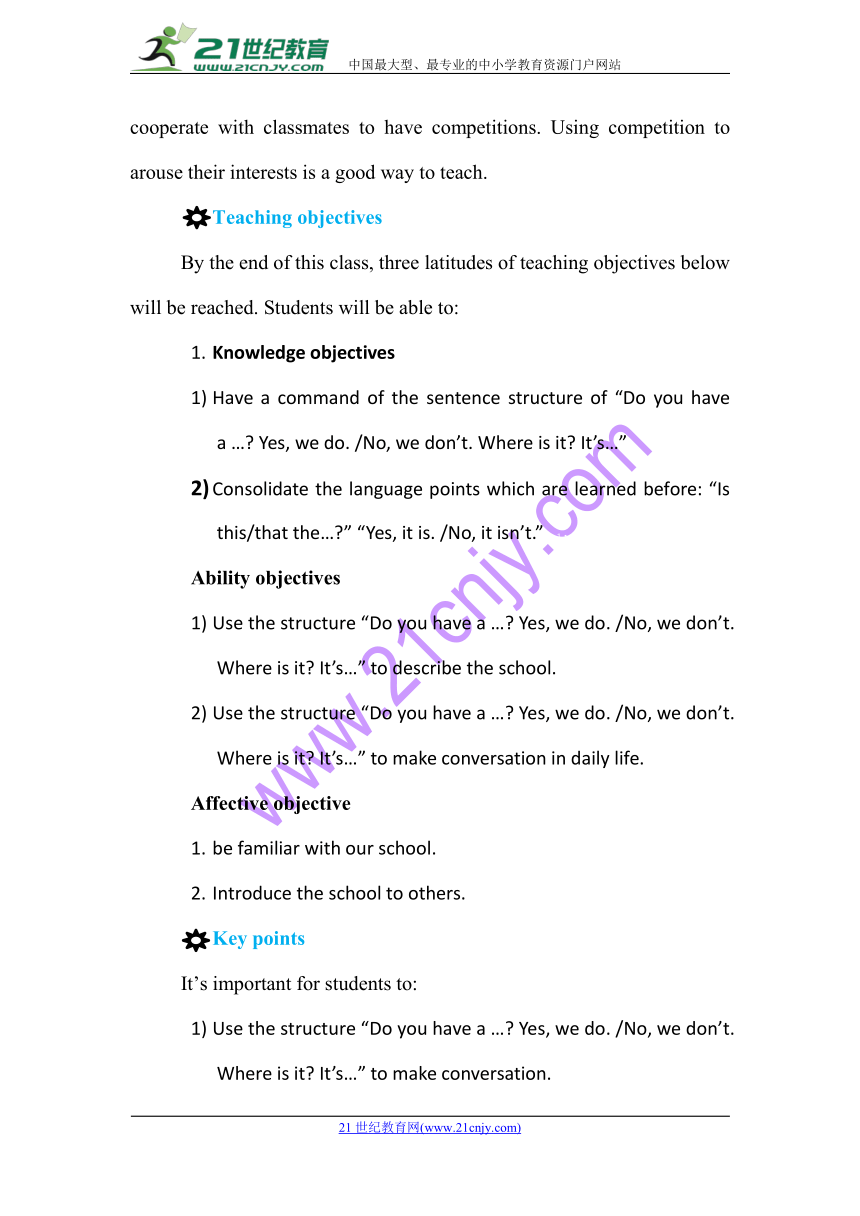Unit 1 My school PB Let’s talk 英文教案
文档属性
| 名称 | Unit 1 My school PB Let’s talk 英文教案 |  | |
| 格式 | zip | ||
| 文件大小 | 63.4KB | ||
| 资源类型 | 教案 | ||
| 版本资源 | 人教版(PEP) | ||
| 科目 | 英语 | ||
| 更新时间 | 2018-06-10 14:41:01 | ||
图片预览



文档简介
PEP Primary English Book 4
Unit1 My school
Part B Let’s talk
Designer: xxx
Students: Grade Four
Duration: 40 min
Teaching material
PEP primary English Book, Part B Let’s talk of Unit 1 My school in book 4.21世纪教育网版权所有
Analysis of teaching material
This unit mainly talks about how to describe something in some places. This lesson consists four key points. First, it is mainly about the usage of the sentence structure of “Is this/that the…” to the conversation and the answering with “yes, it is” or “no, it isn’t. Second, there are new words about the things in school. Those are “library”, “computer room”, “teachers’ office”, “art room”, “music room” and “playground”. Also some new words about the position: “first floor”, “second floor”. Third, it uses structure” where is the…?”to ask the question and uses “It’s on the…”to describe the place of the school. Last, it is mainly about the usage of the sentence structure of “Do you have a…?” to the conversation and the answering with “yes, we do.21教育网
Analysis of students
Usually, students in Grade four have rich life experience and good mathematical and analytical ability. Therefore, some life-related activities will be designed to help their learning. This unit involves the school that students can see in the daily life. So it is necessary to make a connection between the knowledge and life. In grade 4, on the one hand, students have strong awareness of collectivity. On the other hand, they like to cooperate with classmates to have competitions. Using competition to arouse their interests is a good way to teach.21cnjy.com
Teaching objectives
By the end of this class, three latitudes of teaching objectives below will be reached. Students will be able to:www.21-cn-jy.com
Knowledge objectives
Have a command of the sentence structure of “Do you have a …? Yes, we do. /No, we don’t. Where is it? It’s…”
Consolidate the language points which are learned before: “Is this/that the…?” “Yes, it is. /No, it isn’t.”2·1·c·n·j·y
Ability objectives
Use the structure “Do you have a …? Yes, we do. /No, we don’t. Where is it? It’s…” to describe the school.【来源:21·世纪·教育·网】
Use the structure “Do you have a …? Yes, we do. /No, we don’t. Where is it? It’s…” to make conversation in daily life.
Affective objective
be familiar with our school.
Introduce the school to others.
Key points
It’s important for students to:
Use the structure “Do you have a …? Yes, we do. /No, we don’t. Where is it? It’s…” to make conversation.21·cn·jy·com
Use the structure “Do you have a …? Yes, we do. /No, we don’t. Where is it? It’s…” to describe the school.21·世纪*教育网
Difficult points
It may be difficult for students to:
Grasp and distinguish the pronunciation of the words;
Distinguish the usage of “this is…” and “that is…”
Teaching approaches
Task-based Language Teaching Approach
Situational Language Teaching Approach
Communicative Language Teaching Approach
Total Physical Response Teaching Approach
Teaching aids
CAI, board, pictures cards
Teaching procedure
Teaching procedures
Teacher’s activity
Students’ activity
Designer’s purpose
Step one: Warming-up(3min)
1.Let’s sing!
(3min)
Show the
Sing a song together with the teacher clapping hands.
In the beginning ,singing a song can create a safe, happy and relaxing atmosphere for learning
Here, it is also a good chance to listen, speak some necessary words in this lesson.
Step 2: Presentation and practice(28min)
Presentation one (5min)
Show some pictures of the scene in the school. Such as the library, playground, classroom, teachers’ office, computer room.
To show the use of “this and that”, and ask students to use “this, that” to describe the things in the classroom. For example, this is the blackboard. That is the door. ( Use the finger to point the things)
Students look at the picture and answer what it is.
Listen to teacher carefully and try to describe the things in the classroom. Use the finger to point the things in the classroom.
Review the words learned before and it can help students do well in the conversation.
Understand the use of “this and that”. And students can review the things in the classroom. And CLA is used.
Presentation two (5min)
Before listen to the tape, show students some questions of the conversation. (Q: How many students are there in Chen Jie’s class? Where is the library?) And then listen to the tape and answer the questions.
Listen carefully and try to answer the question.
The students will improve their comprehension skills when deciding on the correct answers.
Practice one(4min)
Listen again and read after the tape.
Read together in the class.
Work in pairs to practice the conversation.
Listen to the tape and read it.
All students read together.
Work in pairs.
It can practice students’ spoken English.
CLA is used here.
Practice two
(7min)
Role paly.
Teacher acts as Chen Jie and students act as Report to act the conversation.
Invite one student to act with teacher.
Invite students to act.
Act with teacher and act with classmates.
Act it bravely and actively.
It can make students get involved in the situation.
Make students more engage in the learning.
It is interesting for students to play it.
Practice three
(7min)
Show students a table of school design. And students to ask teacher questions. Use “Do you have a…? / where is it?”
Change the table and ask students to work in pairs to make conversation. Use “Do you have a…? / where is it?”
Share the conversation in class.
Students ask teacher the question.
Students need to cooperate to make conversation.
Share in the class.
It’s easier for students to ask question rather than answer.
Teacher can do an example for students, students can make conversation easily.
Students in this age are active and creative, so we should give students more time to share their ideas.
Students are using full sentences rather than single word answers.
Students are working and becoming familiar with the sentence structure.
The students will often have to apply information given in the text to new situation (problem solve).
Step 3 Extension(7min)
Extension (7min)
Show students some different school. The school is imaginative. For example, some schools are in the sky, some schools are under the water…
Ask students to write a short passage of “My school”. Show students an example. “This is my school. It’s in the sky . We have classroom, teachers’ office and library. I love my school. Ask students to read the example.
Write the a short passage with the help of the example.
Listen to teacher carefully.
Read the example of “my school”.
Write the passage.
It can make students become more imaginative.
With the help of the example, it’s easier for students to write.
It can improve the ability of writing.
Step 4:Conclusion(2min)
Conclusion
(2min)
Help students to review main sentences.
Read the sentences. .
Make a conclusion of the knowledge and have revision.
Homework
Practice the conversation with students of page 7.
Describe your house by using “this is/that is”.
Finish the passage.
Blackboard writing:
Unit1 My school
--part B let’s talk
--Do you have a…?
--Yes, we do./ No, we don’t.
--Where is it?
--It’s on…
